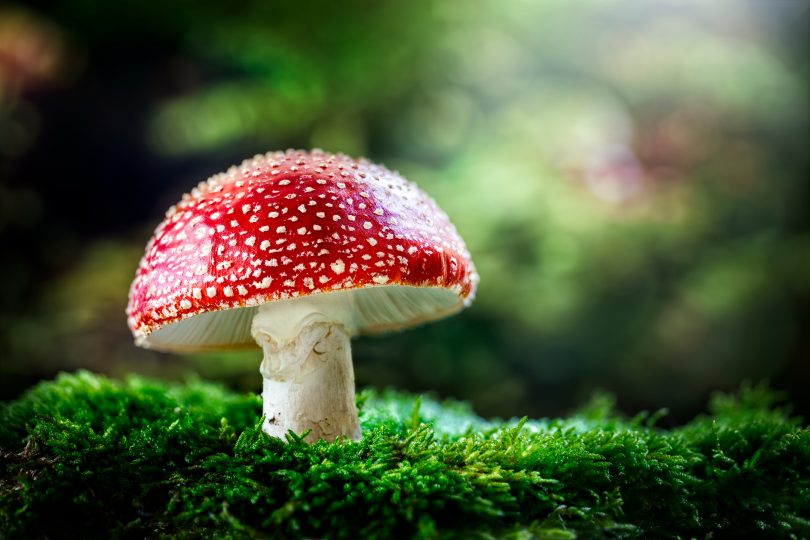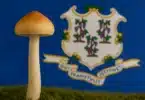Perhaps the most iconic yet misunderstood, hallucinogenic mushroom species on earth is none other than the Amanita muscaria, also known as the fly agaric mushroom. This toadstool mushroom species is one of the oldest types of psychoactive fungi to be used by humans, that we know of, and it is represented somewhat widely in the mainstream media – when you see an animated, whimsical mushroom, it’s typically an Amanita muscaria (like the mushrooms in all the Mario Nintendo games).
By definition, Amanita muscaria is NOT a psychedelic fungus, because its active compounds do not affect the human mind and body same way actual textbook psychedelics do. Rather, it’s categorized as a poisonous mushroom whose side effects may include hallucinations, or ‘trips’. It has been used medicinally, spiritually, and recreationally for thousands of years and is considered a common, old-world substance, although modern-day shroomers typically prefer the psilocybin varieties. Regardless, these mushrooms are widespread and making a comeback, so let’s take a closer look at this ancient entheogen.
What is Amanita muscaria?
Amanita muscaria, often referred to as the fly agaric or fly amanita, is a member of the Basidiomycota family of fungi, of the genus Amanita. This mushroom species gets its common name from its ability to attract and kill flies and possibly, mosquitos.
The fly agaric is native to the temperate and boreal regions of the Northern Hemisphere including Europe, North America, and Siberia/Northern Asia. It’s a highly adaptable mushrooms species that can now be found throughout the world, and it’s closely tied to various deciduous and coniferous trees, commonly found growing under birch and pine.
Amanita muscaria mushrooms have round, often dome-shaped, red caps with white spots and white gills. They are without a doubt one of the most recognizable of the toadstool mushroom species. You can spot Amanita muscaria mushrooms in the Mario franchise games, the Alice in Wonderland mushroom scene, and many other cartoons and animated games.
Although they have many features that make them easily discernible from other mushroom varieties, there are several known subspecies of Amanita muscaria, some more potent/toxic than others. Additionally, new DNA fungi research has discovered that many of the mushroom species often believed to muscarias are actually entirely different species, like the peach-colored fly agaric, which retains is common name although it is not a fly agaric at all.
Muscimol vs psilocybin
Once again, Amanita muscaria does produce hallucinations and altered states of consciousness, by it is not considered to be in the same classification as a formal psychedelic fungus. This is because the active ingredient is different. In classic psychedelics like psilocybin/shrooms, mescaline, and LSD, the active compounds interact with our serotonin and/or dopamine neurotransmitters, which are 5-HT2A agonists.
In A. muscaria, the psychoactive ingredients are muscimol and ibotenic acid. Muscimol activates the major inhibitory neurotransmitter system, gamma amino butyric acid (GABA). As an inhibitory system, muscimol works by suppressing the activity of neurons in the brain. Ibotenic acid is a neurotoxin and agonist of glutamate receptors, specifically at both the N-methyl-D-aspartate, or NMDA, and trans-ACPD receptor sites. Neurotoxins interrupt communication between neurons across a synapse, changing the way the nervous system functions. Ibotenic acid is a secondary metabolite that converts to muscimol via decarboxylation.
While that may sound pretty intense, people who use these mushrooms compare the feeling to being drunk, but with a bit more of a curious and psychedelic vibe to it. The muscimol in these mushrooms can produce feelings of euphoria, hallucinations, muscle jerks, drowsiness, sweating, pupil dilation, and increased body temperature.
Many documents list Amanita muscaria as deadly/fatal, but according to David Arora, an American mycologist, naturalist, and writer, this is incorrect and implies that the mushroom is more dangerous than it really is. Even the North American Mycological Association has stated that there were “no reliably documented cases of death from toxins in these mushrooms in the past 100 years”. Fly agaric mushrooms were used widely in the “old world” but eventually their use faded away as psilocybin mushrooms and truffles, which are more potent and carry less side effects, became increasingly popular and more available.
Psychedelics are exciting, healing compounds with enormous potential. However, when used improperly, there can certainly be some negative side effects. That’s why it’s so important to know what you’re consuming, how to use and get the right dose, and make absolutely sure that you’re not mixing up your intended mushroom with some other fungus. In the meantime, you can find a trove of information in our Psychedelics Weekly Newsletter, your top source for everything related to this growing industry.
Shamanism and old-world customs
Fly agaric mushrooms have been used globally for thousands of years, but they have been most closely associated with the shamanic rituals of ancient Siberia, Northern Europe, and parts of Asia. Numerous cultures and societies in this region were using mushrooms for religious, spiritual, and sometimes recreational purposes. In Siberia specifically, the use of fly agaric mushrooms is believed to precede the crossing of the Bering Strait into North America, which was over 15,000 years ago.
As a matter of fact, the Evenki Northern Tungusic people of that region have an interesting history with fly agaric mushrooms. Every winter, their shamans would dress in thick, wooly garments trimmed with white fur. Then they would go into the woods, pick fly agaric mushrooms and lay them out to dry around the pine trees under which they can be found. After they dried a bit, the shaman would collect all the mushrooms in a large sack and deliver them to the locals by dropping them through a smoke hole in the top of their yurts. The locals would then hang the mushrooms in socks over their fireplaces and continue the drying process. If this all sounds strangely familiar, it’s because this is basically the entire story of Christmas as we know and celebrate it.
In other shamanic cultures, shamans would take the mushrooms and others would drink his urine to feel the psychedelic effects. As weird as that sounds, it was the safest way to consume these mushrooms and still experience the high. The urine still contains all psychoactive elements, but many of the toxins that could cause illness are filtered out. The shaman acts as a sort of buffer to lessen the negative side effects and enhance the benefits of A. muscaria.
Now, these are just the most famous accounts of fly agarics in ancient cultures, but many more exist. Finnish historian T.I. Itkonen wrote about A. muscaria use among the ancient Sami people as well, in which he described shamans or “sorcerers” who would consume fly agarics with seven spots. Back in 1979, two German writers, Said Gholam Mochtar and Hartmut Geerken, published an article detailing the discovery of medicinal and recreational use of this mushroom among a Parachi-speaking group in Afghanistan. There are also unconfirmed reports of religious use of A. muscaria among two Subarctic Native American tribes.
Health benefits
Although not extensively studied in any modern clinical setting, anecdotal accounts of medicinal use go back thousands of years. Amanita muscaria is believed to be helpful in treating numerous different types of neck and back pain, musculoskeletal pain, joint pain, and sciatica.
It also has been said to work on rheumatism, radiculitis, weakness in the limbs, twitching, numbness, and frostbite. Additionally, a fly agaric dilution was used to treat issues with female menstrual cycles and menopause, plus bladder and intestinal cramps. It was frequently used as a treatment for sore throats as well. A. muscaria tinctures were often used topically to treat external issues like nail fungus, minor infections, and skin conditions associated with Lyme disease.
The Koryaks of the Kamchatka Peninsula have a long history of consuming and documenting their use of fly agarics for spiritual and therapeutic purposes. Amanita muscaria has been used as a homeopathic medicine, for physical ailments as well as mental health disorders like depression, anxiety, insomnia, fatigue, and addiction/withdrawal, and even applying it sublingually to help with concentration and energy.
The Koryaks of the Kamchatka Peninsula have a long history of using A. muscaria for shamanic purposes, for healing, and for divination. Amanita muscaria has been used as a homeopathic medicine historically. There are reports of its use to treat a variety of illnesses, including pain, depression, anxiety, insomnia, fatigue, and addiction/withdrawal.
Proper preparation is key
Correct preparation and dosing are essential when consuming fly agarics. Traditionally, they were dried to perfection by local shamans than consumed through various methods, either eating directly or drinking the urine of someone who has eaten them. Nowadays, the drying still applies but people often microdose with Amanita muscaria. Even in very small doses, these mushrooms can produce therapeutic and psychoactive effects.
Throughout Europe, Japan, and parts of North America, A. muscaria is prepared for culinary uses by parboiling and eating as a side dish or mixed with other foods. Like all other aspects of fly agarics, there is not much information on the edibility and nutritional value of eating these mushrooms, but it is said to have a hearty yet sweet, very delicious flavor when cooked properly.
Because many subspecies of Amanita muscaria can be quite toxic, it’s important to make sure you’re using the right kind. The general consensus is that you should only be collecting mushrooms with caps that are bright red in color; never use species that orange or cream/white colored.
Conclusion
Amanita muscaria mushrooms are no longer a commonly used psychedelic mushroom like they were in centuries prior, but they have been getting a bit more attention in recent years. A quick google search will yield quite a few articles, how-to guides, and YouTube videos that explain how to safely utilize this old-world fungus. Me personally, I’ll likely stick to psilocybin mushrooms, because they’re easier to find and I don’t have to worry about negative side effects. But if the opportunity presented itself, I would probably give fly agarics a try, just to see how they feel compared to standard psychedelic varieties.
Hello readers! Thanks for joining us at CBDtesters.co, the #1 internet location for the most recent and interesting cannabis and psychedelics-related news from around the globe. Visit the site everyday to stay abreast of the quickly-moving landscape of legal drugs and industrial hemp, and sign up for The Psychedelics Weekly Newsletter, to ensure you always know what’s going on.
Disclaimer: Hi, I’m a researcher and writer. I’m not a doctor, lawyer, or businessperson. All information in my articles is sourced and referenced, and all opinions stated are mine. I am not giving anyone advice, and though I am more than happy to discuss topics, should someone have a further question or concern, they should seek guidance from a relevant professional.







